LitHub recently published a fascinating piece by Alex Vernon, “Bringing the War Home: How Tim O’Brien Approached the Art of Moral Consequence” (May 27, 2025), in which John Updike featured prominently.
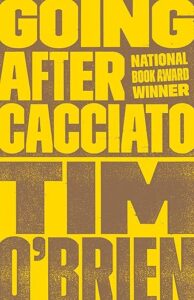 The issue was negative versus positive reviews. Christopher Lehmann-Haupt’s New York Times review was cited as an example of the former, with Lehmann-Haupt arguing that “by repeatedly invoking Catch-22 Mr. O’Brien reminds us that Mr. Heller caught the madness of war better, if only because the logic of Catch-22 is consistently surrealistic and doesn’t try to mix in fantasies that depend on their believability to sustain. I can even imagine it being said that Going After Cacciato is the Catch-22 of Vietnam. The trouble is, Catch-22 is the Catch-22 of Vietnam.”
The issue was negative versus positive reviews. Christopher Lehmann-Haupt’s New York Times review was cited as an example of the former, with Lehmann-Haupt arguing that “by repeatedly invoking Catch-22 Mr. O’Brien reminds us that Mr. Heller caught the madness of war better, if only because the logic of Catch-22 is consistently surrealistic and doesn’t try to mix in fantasies that depend on their believability to sustain. I can even imagine it being said that Going After Cacciato is the Catch-22 of Vietnam. The trouble is, Catch-22 is the Catch-22 of Vietnam.”
Vernon wrote, “Not to worry, as The New York Times Book Review lauded the novel on its front page and didn’t cite Heller. It did bring in Hemingway, as did John Updike’s review in The New Yorker, which struck the opposite note as Lehmann-Haupt’s: ‘As a fictional portrait of this war, Going After Cacciato is hard to fault, and will be hard to better.’
“Cacciato enjoyed plenty of glowing reviews, yet Updike’s review had a huge impact on its success and helped convince the reading world to pay attention to the literature of O’Brien’s war. As O’Brien’s agent’s office wrote to Lawrence, “The John Updike review in The New Yorker seemed to be the word that tipped the scales against resistance to a Viet Nam novel, and now all the scouts are asking for it.”

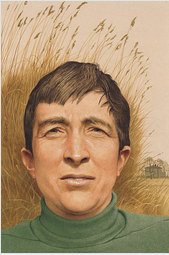 “American novelist John Updike claimed not to write for ego: ‘I think of it more as innocence. A writer must be in some way innocent.’ We might raise an eyebrow at this, from the highly successful and famously intrusive chronicler of human closeness. Even David Foster Wallace, the totem effigy of literary chauvinism, denounced Updike as a ‘phallocrat.’ But if we doubt such innocence of Updike, pronouncing as he was at the flushest height of fiction’s postwar heyday, we might believe it of these new novelists, writing as they are and when they are. Without a promise of glory, and facing general skepticism, they have written from pure motives. They are novelists as Updike defined them: ‘only a reader who was so excited that he tried to imitate and give back the bliss that he enjoyed’.
“American novelist John Updike claimed not to write for ego: ‘I think of it more as innocence. A writer must be in some way innocent.’ We might raise an eyebrow at this, from the highly successful and famously intrusive chronicler of human closeness. Even David Foster Wallace, the totem effigy of literary chauvinism, denounced Updike as a ‘phallocrat.’ But if we doubt such innocence of Updike, pronouncing as he was at the flushest height of fiction’s postwar heyday, we might believe it of these new novelists, writing as they are and when they are. Without a promise of glory, and facing general skepticism, they have written from pure motives. They are novelists as Updike defined them: ‘only a reader who was so excited that he tried to imitate and give back the bliss that he enjoyed’.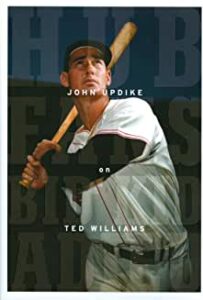 As part of a grand centennial year celebration, an episode of The New Yorker Radio Hour featured
As part of a grand centennial year celebration, an episode of The New Yorker Radio Hour featured  “Welcome to a distinguished residence where historic charm meets modern comfort. Spanning 2 grand Back Bay townhouses, this home offers city living at its finest. Originally built for the Lowell family & later home to John Updike, 151 Beacon features 3 bedrooms, 2.5 baths, & over 2,000 sq. ft. of sophisticated living space. Enjoy direct elevator access, a formal living room w/ gas fireplace, custom built-ins, & oversized windows framing picturesque Beacon Street views. The open-concept kitchen, enhanced by bay windows w/ striking John Hancock Tower views, boasts a central island & a second gas fireplace. The primary suite offers a luxurious retreat w/ an oversized walk-in closet & spacious ensuite bath. 2 additional bedrooms, a powder room, in-unit laundry, & two separate AC/heat units complete the layout. Set in a professionally managed, boutique building of just 6 residences, this home includes 1 tandem parking space & is around the corner from some of Bostons Historic landmarks.”
“Welcome to a distinguished residence where historic charm meets modern comfort. Spanning 2 grand Back Bay townhouses, this home offers city living at its finest. Originally built for the Lowell family & later home to John Updike, 151 Beacon features 3 bedrooms, 2.5 baths, & over 2,000 sq. ft. of sophisticated living space. Enjoy direct elevator access, a formal living room w/ gas fireplace, custom built-ins, & oversized windows framing picturesque Beacon Street views. The open-concept kitchen, enhanced by bay windows w/ striking John Hancock Tower views, boasts a central island & a second gas fireplace. The primary suite offers a luxurious retreat w/ an oversized walk-in closet & spacious ensuite bath. 2 additional bedrooms, a powder room, in-unit laundry, & two separate AC/heat units complete the layout. Set in a professionally managed, boutique building of just 6 residences, this home includes 1 tandem parking space & is around the corner from some of Bostons Historic landmarks.” British writer Diana Evans has written four acclaimed novels and, more recently, a collection of essays titled
British writer Diana Evans has written four acclaimed novels and, more recently, a collection of essays titled  “There are thus good arguments for the premise of John Updike’s Gertrude and Claudius that Hamlet’s father is the truly evil person in the play, and that his injunction to Hamlet is an obscenity. Updike’s novel is a prequel to Shakespeare’s play: Gertrude and Claudius are engaged in an adulterous affair (Shakespeare is ambiguous on this point), and this affair is presented as passionate true love. Gertrude is a sensual, somewhat neglected wife, Claudius a rather dashing fellow, and old Hamlet an unpleasant combination of brutal Viking raider and coldly ambitious politician. Claudius has to kill the old Hamlet because he learns that the old king plans to kill them both (and he does it without Gertrude’s knowledge or encouragement). Claudius turns out to be a good, generous king; he lives and reigns happily with Gertrude, and everything runs smoothly until Hamlet returns from Wittenberg and throws everything out of joint. Whatever we imagine as the (fictional) reality of Hamlet, Gertrude is the only kindhearted and basically honest person in the play.”
“There are thus good arguments for the premise of John Updike’s Gertrude and Claudius that Hamlet’s father is the truly evil person in the play, and that his injunction to Hamlet is an obscenity. Updike’s novel is a prequel to Shakespeare’s play: Gertrude and Claudius are engaged in an adulterous affair (Shakespeare is ambiguous on this point), and this affair is presented as passionate true love. Gertrude is a sensual, somewhat neglected wife, Claudius a rather dashing fellow, and old Hamlet an unpleasant combination of brutal Viking raider and coldly ambitious politician. Claudius has to kill the old Hamlet because he learns that the old king plans to kill them both (and he does it without Gertrude’s knowledge or encouragement). Claudius turns out to be a good, generous king; he lives and reigns happily with Gertrude, and everything runs smoothly until Hamlet returns from Wittenberg and throws everything out of joint. Whatever we imagine as the (fictional) reality of Hamlet, Gertrude is the only kindhearted and basically honest person in the play.” For this entry we need to thank writer
For this entry we need to thank writer 
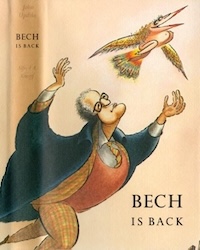 Coming in at #2 was Donald Sassoon’s Becoming Mona Lisa, which traces the path to superstardom of Leonardo da Vinci’s most famous subject/painting—a study that Brown said “suggests that, contrary to popular and scholarly belief, posterity is a peculiarly fickle thing.”
Coming in at #2 was Donald Sassoon’s Becoming Mona Lisa, which traces the path to superstardom of Leonardo da Vinci’s most famous subject/painting—a study that Brown said “suggests that, contrary to popular and scholarly belief, posterity is a peculiarly fickle thing.”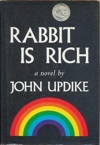 “The third installment of John Updike’s ‘Rabbit’ series finds Harry ‘Rabbit’ Angstrom finally comfortable—or at least financially secure—amid the tumultuous backdrop of 1979’s oil crisis and stagflation. ‘How can you respect the world when you see it’s being run by a bunch of kids turned old?’ the narrator observes, capturing the novel’s eerie contemporary resonance: interest rates and real-estate climbing skyward—and staying there—and a gnawing certainty that the next generation won’t have it quite so good. Updike’s prose transforms the mundane rhythms of middle-class life into something approaching poetry as he excavates middle-class anxiety and success. Rabbit’s car dealership is printing money thanks to the Japanese vehicles he sells, even as his own prejudices and racial anxieties bubble beneath the surface. His son Nelson is adrift, the world seems to be coming apart at the seams and Rabbit’s own biases reflect the tensions of a changing America. The novel won Updike both the Pulitzer Prize and the National Book Award for its devastating precision in capturing what it means to ‘make it’ while watching the ladder get pulled up behind you.”
“The third installment of John Updike’s ‘Rabbit’ series finds Harry ‘Rabbit’ Angstrom finally comfortable—or at least financially secure—amid the tumultuous backdrop of 1979’s oil crisis and stagflation. ‘How can you respect the world when you see it’s being run by a bunch of kids turned old?’ the narrator observes, capturing the novel’s eerie contemporary resonance: interest rates and real-estate climbing skyward—and staying there—and a gnawing certainty that the next generation won’t have it quite so good. Updike’s prose transforms the mundane rhythms of middle-class life into something approaching poetry as he excavates middle-class anxiety and success. Rabbit’s car dealership is printing money thanks to the Japanese vehicles he sells, even as his own prejudices and racial anxieties bubble beneath the surface. His son Nelson is adrift, the world seems to be coming apart at the seams and Rabbit’s own biases reflect the tensions of a changing America. The novel won Updike both the Pulitzer Prize and the National Book Award for its devastating precision in capturing what it means to ‘make it’ while watching the ladder get pulled up behind you.”